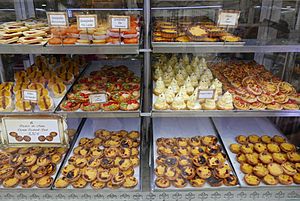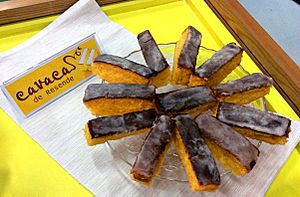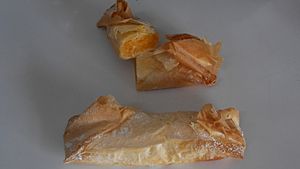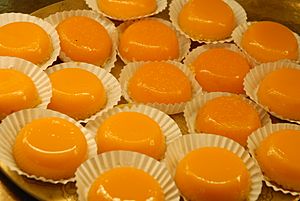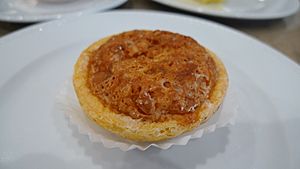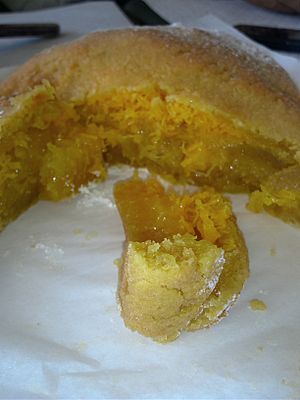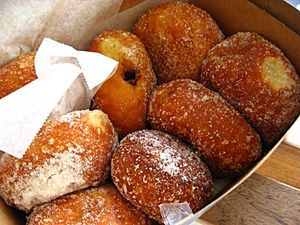Conventual sweets facts for kids
Conventual sweets (called Doçaria Conventual in Portuguese) are a special kind of dessert from Portugal. They are a big part of Portuguese cooking. As their name suggests, these sweets were first made by nuns living in Portuguese convents and monasteries. Starting in the 1400s, these delicious treats became very popular. They are now a key part of Portuguese food, even in places that used to be Portuguese colonies. Conventual sweets often use sugar, egg yolks, and almonds as their main ingredients.
Contents
The Sweet History of Conventual Desserts
Conventual sweets were always eaten in convents. But they became really famous from the 15th century onwards. This was when sugar became much more common. People tried growing sugar cane in the Algarve region first. Then, they grew it on the island of Madeira in the 1400s.
At that time, Portugal made a lot of eggs. Nuns used the egg whites to starch their clothes. This meant they had many extra egg yolks. At first, these yolks were thrown away or fed to animals. But then, a lot of sugar started arriving from Portuguese colonies around the world. This gave the nuns a new idea for the egg yolks!
From the 16th century, making these sweets became a true art. Almost all monasteries and convents in Portugal started making them. In the mid-1800s, a law closed many religious orders in Portugal. The nuns and monks needed money to live. Selling their special sweets was a great way to earn money. These secret recipes were then passed down through families. That is how conventual sweets became a beloved part of Portuguese food today.
Popular Conventual Sweets You Might Find
Many conventual sweets are enjoyed all over Portugal. Here are a few examples of these tasty treats:
- Castanhas de Ovos
- Suspiro
- Cavaca
- Lampreia de ovos
- Pão-de-ló
- Toucinho do Céu
- Filhós
- Rabanadas
- Pastel de nata
- Fios de ovos
- Papo-de-anjo
Sweets from Different Regions of Portugal
Portugal has many different regions, and each one has its own unique conventual sweets. These sweets often use local ingredients or have special traditions.
Minho Region Sweets
The Minho region is known for its beautiful green landscapes. It also has some delicious conventual sweets.
- Meias Luas
- Papas Doces de Carolo
- Pudim Abade de Priscos
- Ovos Moles (often associated with Aveiro, but also found here)
Douro Litoral Region Sweets
This region is famous for its Douro River. It also offers some unique conventual sweets.
- Sapateta
- Perronilha
- Lérias de Amarante
Trás-os-Montes Region Sweets
In the northeast of Portugal, Trás-os-Montes has its own sweet traditions.
- Morcelas
- Jerimús
- Madalenas do Convento
Beira Litoral Region Sweets
Along the central coast, the Beira Litoral region has many famous sweets.
- Pastel do Lorvão
- Nabada de Semide
- Pastel de Tentúgal
- Ovos Moles de Aveiro
Beira Alta & Beira Baixa Region Sweets
These inland Beira regions also contribute to Portugal's sweet heritage.
- Lâminas
- Grade
- Bolo de São Vicente
Ribatejo Region Sweets
The Ribatejo region, known for its bullfighting traditions, also has some sweet treats.
- Sonhos da Esperança
- Palha de Abrantes
- Tigeladas
Estremadura Region Sweets
The Estremadura region, near Lisbon, has many well-known conventual sweets.
- Bom bocado
- Travesseiros
- Brisa do Lis
- Pastel de feijão
Alentejo Region Sweets
The sunny Alentejo region is famous for its wide plains and delicious sweets.
- Bolo podre
- Fatias reais
- Encharcada
- Sericaia
- Pão de rala
Algarve Region Sweets
The southern Algarve region, known for its beaches, has sweets often made with almonds and figs.
- Biscoita
- Bolo de alfarroba
- Doce fino
- Dom Rodrigo
- Massapão

Madeira Islands Sweets
The beautiful island of Madeira has its own unique conventual sweets, often featuring honey.
- Bolo preto
- Bolo de mel
- Bolinhos de azeite
Azores Islands Sweets
The Azores archipelago in the Atlantic also has its own special conventual desserts.
- Bolo micaelense
- Bolo do diabo
- Malassada


